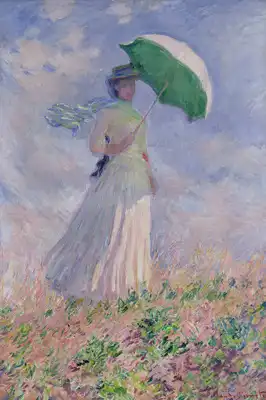About this finishing
Print. The image is printed on the top quality 10-ink HP Z9PS printer on HP matte 270 g / m2 paper. You can choose any size to an accuracy of 1 cm. A margin of 5 cm around the image is added to the size of the motif.


You can find a detailed description about our finishings
here.
Woman with a Parasol
Date:
1886Medium:
oil on canvasLocation:
Musee d'Orsay, Paris, FranceDimensions:
131 x 88After several paintings painted in the sixties of the nineteenth century,
Claude Monet almost completely deviates from the depiction of figures and devotes himself to painting landscapes. When he includes a larger figure in his landscapes, as started to happen again in the eighties, he treats them as if they were part of the landscape. Around the mid-1880s, Monet's attention turns back to the beginnings of his career, returning to figure painting. In one of his open-air studies, Woman with a Parasol, Monet is literally fascinated by the special point of view he chooses for painting. The woman is depicted from below against a blue sky. The young woman in the painting is Suzanne Hoschedé, the daughter of his future second wife, Alice Hoschedé. Suzanne has been one of his favorite models for a long time.
Monet painted picture Woman with a Parasol in 1886. Prevailing color of this fine art print is blue and its shape is portrait. Original size is 131 x 88. This art piece is located in Musee d'Orsay, Paris, France. This image is printed on demand - you can choose material, size and finishing.
Claude Oscar Monet (1840-1926). A native Parisian, who thoroughly developed the idea of
Impressionism. Monet almost scientifically studied the effect of light on different objects. He devoted himself to so called transitory states, which quickly led him to work with colour and light, his paintings acting on the viewer from the first impression. His use of open-air painting and objects which were special only because of light opened the way for the beginnings of modern painting. Monet’s
Impression, Sunrise (1874) not only gave the name to the whole art movement, but secured Monet a place among the best painters of all times. At one time, he resided in London and created his famous study
Houses of Parliament (Monet wondered, How could the English painters paint Parliament when it cannot be seen for the fog?). In the
Giverny, which became his favourite retreat after the death of his wife, he painted motifs from his garden and the popular series
Water Lilies - the world of the water was as poetic and mysterious as a primordial paradise.

